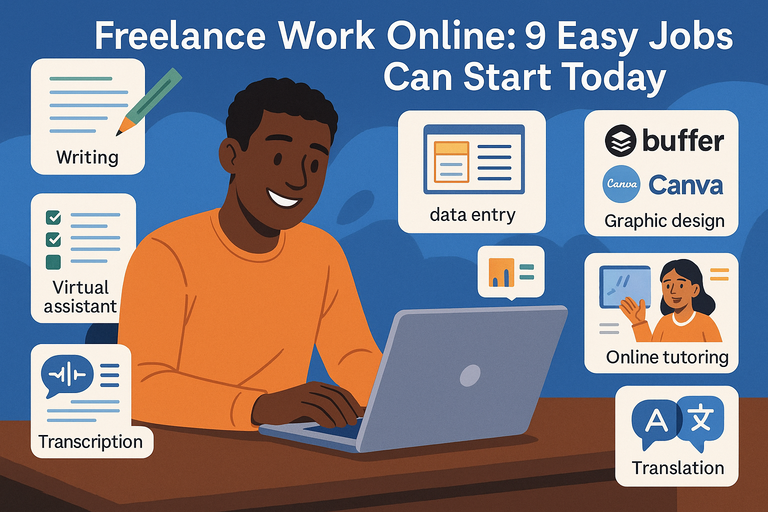Table of Contents
Freelance work online has opened doors for people who want flexibility, independence, and the chance to earn money without being tied to an office.
If you’ve ever wondered, “What are the easiest jobs I can actually start today without years of experience?”—this guide has you covered.
I’ll break down nine beginner-friendly options that anyone with an internet connection can get into quickly, while also giving you a sense of how to grow them into something bigger.
1. Get Started With Freelance Writing Online
Freelance writing online is one of the easiest entry points for people who want to turn words into income.
You don’t need a degree in English or journalism—just a willingness to write, practice, and present your skills in a professional way.
Build Writing Samples That Attract Clients
Clients don’t hire you for potential; they hire you for proof. The simplest way to show proof is by creating writing samples. If you don’t have paid work yet, make your own.
Write a blog post about a topic you know well, create a “how-to” article, or even draft a mock product review.
I suggest creating at least three pieces that show different tones or purposes: one informative article, one persuasive piece (like a product description), and one casual blog post.
You can host these on a free platform like Medium, or even publish them on LinkedIn. The point is to have something live that you can link to when clients ask, “Can I see your work?”
Think of it like a menu at a restaurant. The more variety you show, the easier it is for a client to picture you writing for their project.
Find Beginner-Friendly Platforms for Paid Writing
When you’re just starting, aim for platforms that accept beginners:
- Upwork: Create a profile, highlight your samples, and start applying to small gigs.
- Fiverr: Great for offering set packages like “I’ll write a 500-word blog post for $20.”
- Textbroker: Pays by the word and is beginner-friendly, though rates can start low.
I’ve noticed people often freeze here because they want the “perfect profile.” My advice: don’t overthink it. Upload your samples, write a clear description, and apply. The experience you gain is worth more than waiting for the perfect setup.
Learn How to Set Your Rates Without Undervaluing Yourself
Setting rates feels awkward at first. Many beginners lowball themselves because they’re scared of losing clients. Here’s how I break it down:
- Start by calculating how long it takes you to write 500 words.
- If it takes you an hour, ask yourself: “Am I comfortable earning $10 an hour, or do I need $20?”
- Multiply that by the project length, and that’s your starting rate.
Don’t be afraid to raise your prices after a few projects. Clients value confidence. Even saying, “My rate is $50 for a 1000-word article,” sounds professional. It shows you understand your worth.
2. Offer Virtual Assistant Services From Home
Virtual assistant (VA) work is like being the Swiss Army knife of the digital world. You handle tasks others don’t have time for, and you get paid for it—all from home.
Common VA Tasks You Can Handle Without Prior Training
Most VA jobs don’t require special certifications.
Tasks often include:
- Managing email inboxes (sorting, labeling, replying).
- Scheduling appointments with tools like Google Calendar.
- Updating spreadsheets in Excel or Google Sheets.
- Posting to social media accounts with tools like Buffer or Hootsuite.
When I started dabbling in VA work, I found that small businesses valued someone who could keep their operations running smoothly more than someone with years of “assistant” experience.
If you can follow instructions, stay reliable, and keep things organized, you already qualify.
Platforms Where Virtual Assistants Get Hired Quickly
Here are the fastest ways to find VA jobs:
- Belay: A company that hires U.S.-based VAs for business support roles.
- Time Etc: Designed for flexible, part-time VA jobs.
- Upwork & Fiverr: Ideal for creating profiles that showcase your range of skills.
If you’re brand new, Fiverr is easier to break into because clients come looking for you. Just set up gig titles like “I will manage your emails and scheduling for 5 hours a week.”
Tips to Stay Organized and Deliver High-Quality Support
The difference between an average VA and a great VA is organization. A few tricks I use:
- Use Trello or Asana to track client tasks. Create boards so both you and your client can see progress.
- Keep separate email folders for each client to avoid mixing things up.
- Block work hours and stick to them. Clients love reliability more than speed.
Here’s the kicker: Communication matters more than technical skills. Even a short “Just letting you know I’ve completed today’s tasks” goes a long way in making clients trust you.
3. Explore Data Entry Freelance Jobs Online
Data entry gets a bad rap for being “boring,” but it’s one of the most straightforward ways to dip your toes into freelance work online.
It’s task-based, requires almost no learning curve, and you can start quickly.
Why Data Entry Is Perfect for Absolute Beginners
If you can type and follow instructions, you can do data entry. The tasks are often simple: copy text from one spreadsheet to another, enter survey results, or clean up databases. It doesn’t sound glamorous, but here’s why I like it: it builds discipline.
When I first tried data entry, I learned how to work consistently online. Even though the pay wasn’t huge, it gave me a sense of routine. That habit of “logging in, doing tasks, and meeting deadlines” carried over to better-paying freelance gigs later.
Best Sites to Land Entry-Level Data Entry Gigs
Here’s where to look:
- Clickworker: Offers micro-tasks, including data entry.
- Amazon Mechanical Turk (MTurk): Small, repetitive tasks that add up over time.
- Upwork: Tons of data entry job postings—just filter for entry-level.
- Freelancer.com: Competitive, but a reliable marketplace.
If you want a faster way to filter scams, check whether the platform pays directly through their system (like Upwork or Fiverr). That way, you’re never wiring money to strangers.
How to Avoid Low-Paying or Scam Job Offers
Data entry attracts scams because it’s so easy to claim “anyone can do it.” Red flags to watch out for:
- Jobs that ask you to pay for training materials.
- Employers who want you to buy software before starting.
- Rates that seem too good to be true (like $500 for 1 hour of work).
I recommend sticking to reputable platforms until you have enough experience to spot red flags yourself. A simple rule I live by: if a job feels shady, it probably is.
4. Start Earning as a Freelance Social Media Manager
Social media management is one of the most in-demand ways to do freelance work online because every business wants to look good on Instagram, TikTok, or LinkedIn but few have the time to stay consistent.
Beginner Tools to Manage Multiple Accounts Easily
When you’re managing more than one account, logging in and out all day is a recipe for burnout. That’s where tools save you.
- Buffer: From the dashboard, click “Publishing” > “Create Post.” You can upload one piece of content and schedule it across multiple platforms at once.
- Canva: Use their “Templates” section to quickly create social posts without design experience. I’ve used Canva to produce an entire month’s content calendar in under an hour.
- Meta Business Suite: If you’re handling Facebook and Instagram, this free tool lets you schedule posts and check engagement without needing third-party apps.
I suggest starting with one tool and mastering it. Don’t overwhelm yourself with 10 dashboards—clients care more about results than fancy software.
Simple Strategies to Attract Your First Social Media Clients
Getting your first social media gig often feels harder than managing the accounts themselves. What worked for me was showing proof before being paid.
I picked one local café, created a week of Instagram content in Canva, and sent it to them as a free sample. They hired me the next week.
You can also:
- Post your own content tips on LinkedIn to show you know your stuff.
- Offer a small “trial package” like 10 posts for $50.
- Join Facebook groups for small business owners—many post “Need a social media person ASAP.”
Think of it as auditioning. Once people see you can deliver, they’ll start referring you.
Turning Small Gigs Into Long-Term Client Relationships
Short projects can evolve into contracts if you show clients two things: reliability and results.
- Share simple reports. Even screenshots of follower growth or post reach look professional.
- Communicate weekly. I send a “This week’s wins” email to keep clients updated.
- Suggest ideas. If you notice their TikTok trend is working, tell them. They’ll see you as a partner, not just a contractor.
The trick is not just doing the work but making the client feel like you care about their brand as much as they do.
5. Make Money With Freelance Graphic Design Projects
Freelance graphic design doesn’t require you to be the next Picasso. With free tools and a little creativity, you can start today—even without formal training.
Free and Affordable Tools for Non-Professional Designers
Design used to mean expensive Adobe software, but now anyone can create high-quality graphics with beginner tools:
- Canva: Drag-and-drop simplicity. Templates for logos, social media posts, flyers.
- Photopea: A free, browser-based Photoshop alternative. Great if you need advanced edits.
- Figma: Ideal for designing websites or app layouts.
I believe Canva is the best starting point. From the dashboard, just click “Create a Design,” pick your format (like Instagram Post), and you’re ready.
Places Where Graphic Designers Get Hired Fast
Design clients are everywhere once you know where to look:
- Fiverr: Create a “gig” offering logo or social media design.
- Upwork: Great for longer projects like branding kits.
- 99designs: Competition-based, but you can land big clients if you win.
- Direct outreach: DM local businesses on Instagram with a sample design mock-up.
When I first started, I mocked up a new menu for a local food truck and sent it to them. They loved it and paid me to refine it. That one project snowballed into referrals.
How to Showcase a Portfolio Without Formal Training
No degree? No problem. You just need to show examples of your work.
Here’s what you can do:
- Create 5–10 sample designs in Canva. Pretend they’re for real businesses.
- Upload them to a free portfolio site like Behance or Dribbble.
- Share links in your job applications.
Clients care less about your resume and more about “Can you design something that looks good?” If your portfolio answers yes, you’re in.
6. Try Online Tutoring and Teaching Freelance Work
Teaching online is another great way to do freelance work online, especially if you already have a subject you know well.
With the rise of e-learning, parents, students, and professionals are actively looking for one-on-one help.
Subjects and Skills in High Demand for Online Tutors
Not every subject pays the same. Right now, demand is high for:
- Math and science tutoring (especially for middle and high school).
- English as a Second Language (ESL).
- Coding and computer skills.
- Test prep for SAT, ACT, IELTS, or GRE.
I once tutored high school English online, and I found that what parents wanted most wasn’t perfect grammar lessons but someone who could build their kid’s confidence. That’s where your personal touch comes in.
Platforms That Connect Tutors With Students Worldwide
The easiest way to start tutoring is to join platforms that already have students waiting:
- Preply: Great for teaching languages, including English.
- Wyzant: Lets you set your own rates and subjects.
- VIPKid: Focused on teaching English to kids in Asia.
- Outschool: Lets you create group classes on almost any subject.
From the dashboard of Preply, you can set your hourly rate and availability. Once approved, students can book directly with you.
Tips for Building Trust and Confidence as a New Tutor
Tutoring isn’t just about teaching—it’s about connecting. To build trust:
- Start sessions by asking about the student’s goals.
- Use simple online tools like Google Docs or Zoom’s whiteboard to make lessons interactive.
- Always end with a recap of what was learned and a preview of the next lesson.
I suggest recording (with permission) short clips of your lessons to review your own teaching style. It helps you improve and shows students you take the work seriously.
Over time, happy students often turn into repeat clients or even refer friends. That’s how you build a steady tutoring income without constant hustling.
7. Do Freelance Transcription Jobs Online
Transcription is one of those freelance work online options where you get paid to listen carefully and type accurately. If you’re detail-oriented and patient, it’s a straightforward way to earn money.
Skills That Make You Stand Out as a Transcriber
Anyone can type, but the best transcribers share a few skills:
- Fast and accurate typing: Aim for 60+ words per minute with minimal errors. Free tools like TypingTest.com help you practice.
- Good listening skills: Accents, background noise, and technical jargon will test you. Train yourself by transcribing podcasts or YouTube videos.
- Formatting discipline: Clients expect transcripts in a clean, readable format. Knowing when to use [inaudible] or time stamps makes you look professional.
I once worked on an audio file where the speaker had a heavy accent and a dog barking in the background. It wasn’t about perfection—it was about producing the clearest transcript possible. Clients appreciate effort and honesty more than flawless output.
Websites That Offer Reliable Transcription Work
The safest way to start is by joining platforms that pay through their systems:
- Rev: Beginner-friendly, lets you pick short files.
- Scribie: Small projects, great for practice.
- TranscribeMe: Pays per audio minute, flexible for part-time work.
- GoTranscript: Reliable payouts and helpful support.
From the Rev dashboard, you can filter files by length and difficulty. I recommend starting with short, clear audios to build confidence.
Mistakes to Avoid When Starting With Transcription
Beginners often fall into traps that make the job harder than it should be:
- Taking files that are too long—it’s better to nail 5 minutes than struggle with 60.
- Ignoring guidelines—platforms give formatting rules, and following them sets you apart.
- Underestimating fatigue—typing for hours can hurt your hands. I suggest breaks every 30 minutes.
Think of transcription as a skill-building gig. Even if the pay starts low, it teaches focus, discipline, and attention to detail—skills you’ll use in any online job.
8. Launch a Freelance Career in Customer Support
Customer support may not sound glamorous, but it’s the backbone of many online businesses.
As companies go remote, they need freelancers who can answer questions, solve problems, and keep customers happy.
Types of Customer Service Roles You Can Do Remotely
There’s more variety than most people realize:
- Live chat support: Replying to customers through chat widgets on websites.
- Email support: Handling tickets in systems like Zendesk or Freshdesk.
- Phone support: Answering calls from home using VoIP tools.
- Social media support: Responding to customer comments and DMs.
If you’ve ever worked retail or hospitality, those same skills transfer online. It’s about patience, empathy, and clear communication.
Tools to Stay Productive While Handling Support Requests
Customer support can get overwhelming if you don’t have systems. A few tools make life easier:
- Zendesk: Keeps tickets organized. You can tag, prioritize, and resolve issues from one dashboard.
- Slack: Used for team communication—you’ll often need to check with others before answering.
- Google Sheets: Surprisingly useful for tracking FAQs or issues clients want monitored.
I’ve used Zendesk, and my favorite shortcut is the “Macros” feature. It lets you create canned responses (like refund policies) so you don’t type the same answer 50 times a day.
How to Handle Difficult Customers Without Stress
Here’s the hard truth: not every customer will be kind. Some will be impatient, frustrated, or even rude. The key is detaching yourself.
- Start with empathy: “I understand this must be frustrating.”
- Offer solutions, not excuses. Instead of “That’s not possible,” try “Here’s what we can do instead.”
- Know when to escalate—don’t waste energy fighting battles you can’t win.
I once handled a client who emailed five times in 10 minutes. Instead of reacting, I drafted a calm, detailed response with clear next steps. The result? They thanked me at the end.
Customer support teaches you resilience—and resilience is a currency in freelance work online.
9. Explore Freelance Translation Jobs If You’re Bilingual
If you’re fluent in more than one language, translation can turn that skill into real income. It’s one of the most valuable niches in freelance work online because businesses constantly need to reach global audiences.
Languages That Pay the Most in Translation Work
Not all languages are valued equally in the freelance market. The highest-paying often include:
- Japanese
- German
- Arabic
- Chinese (Mandarin)
- Scandinavian languages
English paired with these high-demand languages can command strong rates. For example, English-to-German translations often pay more than English-to-Spanish because fewer freelancers cover that niche.
Trusted Marketplaces to Find Translation Gigs Online
To avoid scams, I recommend sticking with well-established platforms:
- ProZ: A hub for professional translators with project listings.
- TranslatorsCafe: Freelance marketplace dedicated to translation.
- Upwork: General platform with strong translation demand.
- Fiverr: Good for offering specific translation packages.
ProZ, in particular, lets you showcase credentials, upload samples, and bid on serious projects. It feels more like a professional association than just a gig site.
How to Build Authority Even Without Certifications
Not having a translation degree doesn’t mean you can’t succeed. What matters is proving fluency and reliability. Here’s how:
- Translate 2–3 sample documents (like a product manual or a blog post).
- Share side-by-side examples in your portfolio.
- Offer small trial jobs at a fair rate to gather reviews.
Clients want accuracy and cultural nuance, not just literal word swaps. I suggest always asking, “Who’s the target audience?” because that shapes your tone. A business proposal in German reads differently than a casual blog post in Spanish.
Expert Tip to Get Started Fast
Pick just one freelance path to begin with, even if others sound tempting. Mastering transcription, customer support, or translation will give you confidence and momentum. Once you’ve built experience in one lane, it’s much easier to branch into others.
I believe the biggest mistake beginners make is trying everything at once. Focus brings clarity, and clarity brings income.






